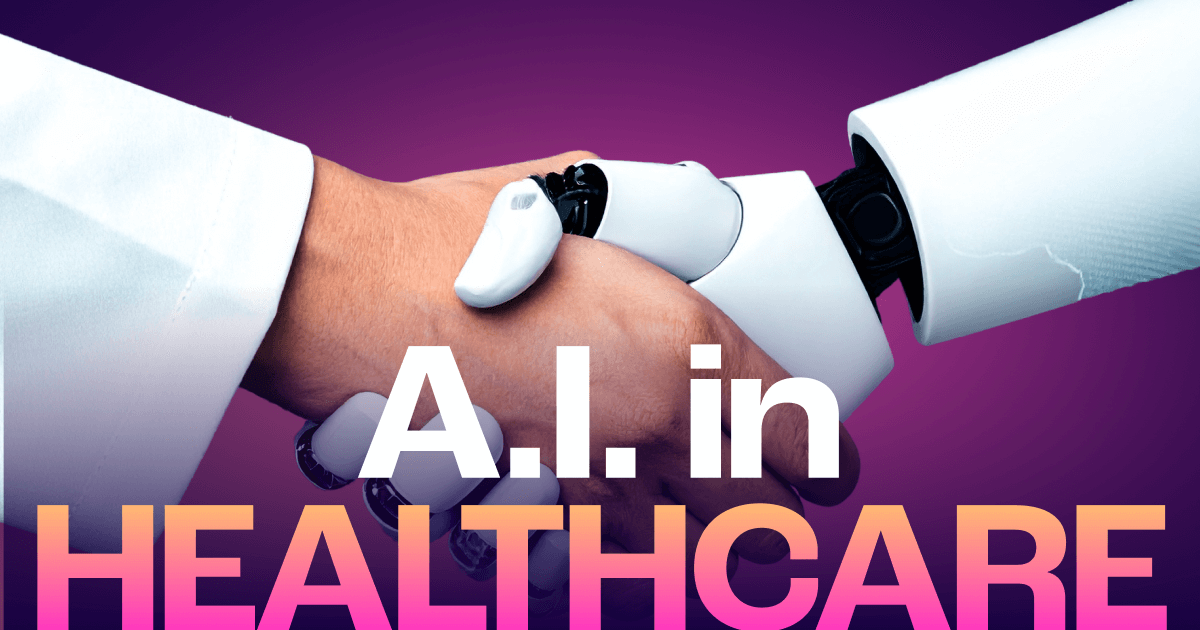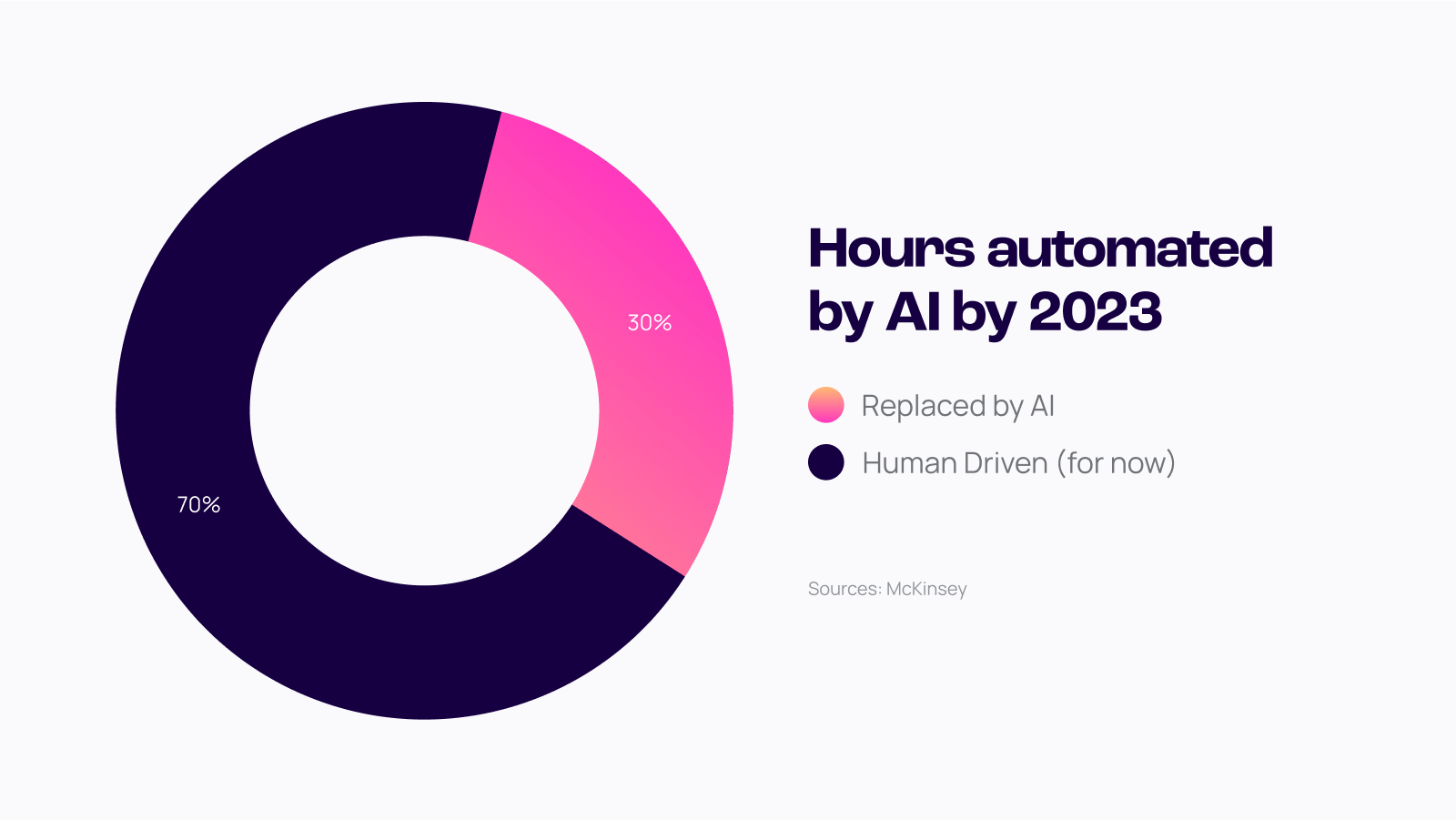
AI vs. Doctors 🤖🥊🧑⚕️ 10 AI-Proof Healthcare Jobs
Artificial intelligence (AI) is not coming for healthcare—it’s ALREADY HERE!
From billing clerks to hospital executives, even healthcare administrators wonder: will AI replace healthcare jobs?
The reality is more nuanced.
AI isn’t replacing entire professions overnight—it’s reshaping tasks inside them.
Some healthcare jobs will be replaced by AI, especially those that are repetitive or deal with data analysis, while others will evolve to use AI as a powerful tool.
In this article, we’ll explore which healthcare workers and doctors are most exposed, what jobs will AI replace in healthcare, and how humans and machines can collaborate to improve patient care.
A brief Evolution of Healthcare Technology
1960s to present
From early mainframes crunching insurance claims in the 1960s to today’s cloud-connected diagnostics, healthcare has always adopted tech in bursts.
The present wave adds machine learning, sensors, and ambient AI-driven scribes that listen and draft clinical notes in the background. This frees up doctors to spend more time interacting with patients than glued to their screen inputting data.
How Is AI Reshaping Healthcare?
Hospitals use FDA-cleared AI tools for imaging, triage, clinical decision support, documentation, and revenue cycle work. The U.S. Food and Drug Administration maintains a public list of AI/ML-enabled medical devices; the database has surged to the hundreds in recent years and keeps growing, showing how fast real products—not just demos—are entering care.
Why AI is Booming in Healthcare
Three drivers: cost pressure, staff shortages, and measurable outcomes.
Regulators and health systems now track AI formally (ethics, governance, and safety) while pushing to capture time savings and error reduction. WHO’s guidance underscores that AI must be transparent, accountable, and equitable—guardrails that actually speed adoption by clarifying the rules.
The Need for AI in Healthcare
So will AI replace healthcare jobs? It’s a question every clinician and administrator is starting to ask. We’ve already established that AI won’t completely replace healthcare professionals, but here are the top areas where AI is being implemented in 2025:
🎯 Diagnostics and treatment planning
In radiology, cardiology, dermatology and beyond, models flag abnormalities, prioritize worklists, and suggest likely differentials.
Meta-analyses of real-world deployments report efficiency gains when AI serves as a second reader, and controlled studies comparing clinicians and models routinely find complementary strengths: AI can narrow options fast, but expert physicians still outperform on complex cases.
🧑⚕️ Surgical assistance
Robot-assisted platforms translate a surgeon’s hand movements into micro-precise actions, reduce tremor, and can enable smaller incisions. Intuitive’s da Vinci systems alone account for over 14 million procedures to date, with global case volumes still rising. That’s augmentation, not replacement—the robot is a tool, the surgeon is in charge.
Beyond the robot itself, computer vision now analyzes surgical videos to track steps, benchmark performance, and auto-draft post-operative notes—promising documentation that’s both faster and more accurate than surgeon dictation alone.
📈 Predictive analytics
Models trained on EHRs and public data forecast admissions, deterioration risk, and even regional outbreaks. This helps public health teams target interventions and monitor infectious-disease spread more precisely than manual surveillance alone.
Evidence from imaging and diagnostic studies shows that human-AI collaboration can reduce workload while maintaining (or improving) sensitivity.
📊 Patient data management
AI systems classify documents, extract key fields, and reconcile records across systems, which reduces duplicate tests and billing errors and gives clinicians a cleaner, broader view of the patient. Revenue-cycle leaders report double-digit gains in denial prevention when they combine AI coding with predictive audit rules.
🦾 Wearables and remote monitoring
Consumer devices now ship with regulated features—Apple’s irregular-rhythm notification, for example, received FDA De Novo authorization and has since expanded through 510(k) updates. Systematic reviews show remote patient monitoring can improve metrics like blood pressure control and diabetes A1c when programs are well-designed.
🫶 Mental-health support
AI chatbots can deliver education, mood tracking, and coping strategies between sessions. Early evidence suggests gen-AI can draft empathetic message replies that lighten clinician inboxes—with human review before sending.
⏰ Administrative automation
Scheduling, intake, prior auth, and billing are ripe for automation. Reviews and governmental briefings note chatbots that allow patients to interact with AI assistants and book appointments, while ambient tools capture clinical conversations and auto-populate charts—saving hours per week for physicians.
What Healthcare Jobs Will be Replaced by AI?
The biggest question; will doctors be replaced by AI? With the rise of ChatGPT and Grok, many individuals turn to AI chats before medical professionals. But does this really mean doctors are going to disappear from the healthcare industry?
Absolutely not!
Let’s get precise: most occupations won’t be fully automated, but a large share of activities inside them will be. McKinsey estimates technologies including generative AI could automate up to 30% of hours worked by 2030, with healthcare administration especially exposed.

Highest-risk task clusters
Billing and coding, prior-authorization prep, claims scrubbing, documentation scribing, radiology worklist triage, routine image measurements, and transcription—work that’s rule-based and data-heavy.
Studies already show AI outperforming humans on narrow tasks like long-term rhythm interpretation, while radiology tools increasingly act as first-pass readers that push likely positives to the top.
Timeline snapshot:
So you might be wondering just how many jobs will AI replace in healthcare? Or what exactly will be automated in the future.
Here’s a brief look into the future:
- By 2030: Broad adoption of AI scribes, automated coding, basic imaging triage; large reductions in manual scheduling and transcription.
- By 2040: End-to-end digital front doors (chat + scheduling), routine RPM for chronic disease, and wide use of decision support in primary care; fewer entry-level admin roles.
- By 2050: Mature AI orchestration across care pathways—humans still decide, but machines coordinate, predict, and pre-document most steps.
These timelines reflect current adoption rates and regulatory posture, with the count climbing each year.
10 AI-Proof Healthcare Jobs, Skills & Roles
Aging populations and rising acuity mean human-centered care is booming—even as tools get smarter. These ten roles (many clinical, a couple health-adjacent) have the strongest human edge.
1) Nurse Practitioners
🌟 Why AI won’t replace NPs: Diagnosis and treatment planning depend on context, rapport, and iterative judgment—things a model can’t fully replicate at the bedside.
🔑 Core responsibilities: Diagnose and manage acute and chronic conditions; prescribe treatments; educate families.
🙋♀️ Human skills: Empathy, cultural fluency, and clinical judgment in ambiguous presentations.
💰 Pay & outlook: Median annual wage for NPs and related APRN roles was $132,050 (May 2024); growth for NPs is among the fastest in healthcare this decade.
🤖 Use AI wisely: Decision-support for drug interactions, RPM dashboards for high-risk patients, and ambient note-taking with careful review.
2) Choreographers (health-adjacent)
🌟 Why they’re hard to automate. Movement design is creative, embodied, and responsive to performers—key in dance-therapy and rehab settings.
🔑 Core responsibilities. Create routines, teach movement, adapt to bodies in front of them.
🙋♀️ Human skills. Creative direction, interpretation, and motivational coaching.
💰 Pay & outlook. Median hourly wage $26.73 (May 2024); employment projected to grow modestly through 2033.
🤖 Use AI wisely. Motion-capture tools to analyze form; AI-assisted music editing.
3) Physician Assistants
🌟 Why AI won’t replace PAs: They combine procedural skills with bedside judgment, adapting plans in real time.
🔑 Core responsibilities: Exams and procedures, diagnosis, post-operative support.
🙋♀️ Human skills: Critical thinking, counseling, and team coordination.
💰 Pay & outlook: Median annual wage $133,260 (May 2024); projected U.S. growth 28% (2023–33).
🤖 Use AI wisely: Imaging decision support, automated chart updates, and early-warning dashboards.
4) Mental Health Counselors
🌟 Why AI won’t replace them: Therapy hinges on trust and attunement; bots can support but not substitute.
🔑 Core responsibilities: Individual/group counseling, treatment plans, crisis work.
🙋♀️ Human skills: Active listening, empathy, cultural awareness.
💰 Pay & outlook: Employment is projected to grow ~19% (2023–33); pay varies by setting.
🤖 Use AI wisely: Note-taking helpers, mood-tracking apps between sessions—always with informed consent.
5) Nursing Instructors
🌟 Why AI won’t replace them: Mentorship, simulation debriefs, and clinical judgment are inherently human.
🔑 Core responsibilities: Curriculum, clinical supervision, assessment.
🙋♀️ Human skills: Clear teaching, coaching, and real-time problem solving.
💰 Pay & outlook: Pay lands solidly in the mid-$80Ks with healthy demand as nursing programs expand.
🤖 Use AI wisely: Auto-graded quizzes, virtual simulation, and skills-lab analytics.
6) Coaches & Scouts (health-adjacent)
🌟 Why AI won’t replace them: Motivation and trust are human; spotting “intangibles” doesn’t reduce to a metric.
🔑 Core responsibilities: Skill development, performance analysis, talent ID.
🙋♀️ Human skills: Leadership, emotional support, split-second decisions.
💰 Pay & outlook: Median annual wage $45,920 (May 2024); projected growth 9% (2023–33).
🤖 Use AI wisely: Video analytics, injury-risk modeling, and load-management dashboards.
7) Athletic Trainers
🌟 Why AI won’t replace them: Hands-on assessments and trust during rehab are human to the core.
🔑 Core responsibilities: Evaluate and treat sports injuries; create rehab plans.
🙋♀️ Human skills: Physical guidance and clear communication.
💰 Pay & outlook. Median wage $60,250 (May 2024); projected growth 13% (2023–33).
🤖 Use AI wisely: Motion analysis and automated progress tracking.
8) Physical Therapists
🌟 Why AI won’t replace them: Personalized, hands-on therapy and motivational coaching.
🔑 Core responsibilities: Mobility evaluation, rehab programming, injury prevention.
🙋♀️ Human skills: Demonstration, real-time adjustment, encouragement.
💰 Pay & outlook: Median pay now tops $101,020 (May 2024) nationally; demand remains strong as populations age. Bureau of Labor Statistics
🤖 Use AI wisely: Gait analysis tools, remote-exercise monitoring.
9) Orthotists & Prosthetists
🌟 Why AI won’t replace them: Devices must be designed, fitted, and iterated with the person—not just the scan.
🔑 Core responsibilities: Measure, fit, and tune devices; patient education.
🙋♀️ Human skills: Craftsmanship, creative problem-solving, empathy.
💰 Pay & outlook: Median pay $78,310 (May 2024) with 15% projected growth to 2033 as technology expands access.
🤖 Use AI wisely: AI-guided design + 3D printing for faster, more precise fits.
10) Occupational Therapists
🌟 Why AI won’t replace them: Daily-living coaching is deeply personal.
🔑 Core responsibilities: Assess needs, design plans, support families.
🙋♀️ Human skills: Creative adaptation, patience, communication.
💰 Pay & outlook: National median near $98,340 (May 2024) with aging-population tailwinds.
🤖 Use AI wisely: Home-safety assessments and wearables data to personalize tasks.
Will AI Replace Surgeons?
Short answer: no.
But surgeons who use AI may replace those who don’t.
The systems in operating rooms remain tools under human control; adoption requires capital, training, and rigorous credentialing, which slows hype cycles and protects safety.
Health-system leaders consistently frame AI as augmentation, not substitution, and list compassion, ethics, and creative problem-solving as the distinctly human edge.
Want to see what the future looks like? Watch a surgical robotics explainer from your hospital’s vendor of choice—then read the clinical papers behind it. (If you’re curious about the adoption scale, start with da Vinci’s cumulative procedures figure.)
How Healthcare Workers Can Adapt and Leverage AI
- Get AI-literate: Learn how models are trained, where they fail, and how bias creeps in. Some JAMA studies show that biased AI can pull clinicians off the right diagnosis—a reminder that oversight is non-negotiable.
- Train on real tools: Pilot ambient scribes, RPM dashboards, and imaging decision support with your IT and compliance teams. Several large systems report big documentation time savings after deployment.
- Upskill: Many vendors and universities now offer short courses on AI in medicine, model governance, and prompt-safe documentation.
- Measure outcomes. Track cycle times, error rates, DSH index, readmissions, A1c, or blood pressure control to prove value. Reviews document RPM gains when programs are well-designed and supported.
How Companies Are Using AI in Healthcare Right Now
🏥 Hospitals and healthcare systems
Ambient listening tools (e.g., AI scribes and natural language processing AI algorithms) at academic medical centers capture visits and draft notes, often cutting paperwork from hours to minutes. Surgical video analytics auto-compose op notes and may benchmark procedural steps.
🚀 Startups and platforms
New players focus on imaging, administrative automation, and patient messaging. Systematic reviews find that gen-AI can draft empathetic, high-quality replies to patient messages and lighten inbox load, again with human oversight.
🙋♀️ Public-sector guardrails
WHO and others publish governance frameworks to steer deployment toward safety, transparency, and equity. The FDA’s device list adds transparency about which marketed tools actually use AI, helping clinicians choose responsibly.
Practical Advice to Stay Relevant
- Lead with the human edge. Empathy, ethics, and judgment aren’t optional; they’re your moat.
- Master workflow, not just apps. Map how data moves from intake to billing and find the bottlenecks AI can unblock.
- Build a mini-portfolio. Capture before/after metrics for a pilot (e.g., “reduced documentation time by 40%” or “improved hypertension control”), and include de-identified screenshots. Business Insider
- Stay current. Skim FDA device updates and your specialty society’s AI guidance once a quarter; save examples where models helped or hurt. U.S. Food and Drug Administration
- Network smart. Join your hospital’s AI council or quality-improvement group to learn the governance ropes—and to be in the room when pilots launch.
At-Risk Roles and Tasks: A Closer Look
Administrative workflows: The U.S. spends staggering sums on administration—analyses peg it at 15%–30% of total health spending. That’s exactly the terrain where AI shines: automated coding, claims scrubbing, and prior-auth prep. Revenue-cycle operations already report five-figure monthly hour savings with AI document processing and denials prediction.
Medical transcription: As ambient listening tools spread, standalone transcription is contracting; BLS projects a 5% decline (2023–33) for medical transcriptionists. Many will upskill into QA roles—editing AI-drafted notes and ensuring compliance.
Records and coding: Unexpectedly, medical records specialists are projected to grow ~9% as the data footprint expands and new credentials emerge (e.g., audit and registry roles). The frontline work shifts from typing to supervising algorithms and solving exceptions.
Imaging support: AI will increasingly handle measurements and first-pass triage. Radiologists remain accountable for synthesis, communication, and management decisions—work that draws on anatomy, risk, and patient context that no single model “sees.”
Real-World Case Studies You Can Point To
- Surgical video to narrative: Computer-vision systems that watch robot-assisted surgeries can assemble post-op notes with fewer discrepancies than human dictation. It’s still reviewed by the surgeon, but gives a huge head-start.
- Ambient scribes at scale: Academic medical centers (e.g., Stanford Health, Mass General Brigham) deploy AI listening tools that cut documentation time dramatically and improve patient eye contact, with continuing oversight for accuracy and consent.
- Revenue-cycle automation: Large outsourcing firms report 15,000+ hours saved per month by pairing RPA with AI document understanding across millions of transactions—evidence that back-office automation is here now.
Training & Credentials That Signal You’re AI-Ready
- AI literacy for clinicians: Short CME courses in model basics, prompt-safe documentation, and bias mitigation. Combine them with QI training so you can measure a pilot’s impact.
- Health-informatics certificates: If you’re non-clinical, certificates in health informatics or registry science align with rising demand for health information technologists (projected +16% through 2033).
- Specialty-specific upskilling: For nurses and therapists: RPM program design, device selection, data triage protocols. For administrators: payer policy, denials analytics, and privacy law for AI.
Balancing AI and the Human Touch in Healthcare
Here’s the big picture: healthcare has a people shortage, not a people surplus.
Global bodies still project significant clinician gaps by 2030, which means demand for human care stays high even as tools get better. AI technologies will take the busywork, surface patterns, and keep watch in the background; clinicians will connect, decide, and explain.
That division of labor is good news for healthcare organizations, allowing AI to support professionals in improving patient outcomes.
Explore in-demand healthcare roles and AI resources in the Paybump portal. You’ll find resume templates, job leads, and step-by-step playbooks to pilot AI safely in your setting.
Subscribe to our newsletter for a welcome offer and fresh, practical career insights and tips—then put them to work on your next shift.
FAQs
Will AI replace doctors in the future?
AI may handle narrow, repetitive tasks, but doctors will remain essential for empathy, trust, and complex decision-making.
Will AI replace healthcare workers?
Some roles will see tasks automated, but patient-facing jobs like nursing, therapy, and counseling rely on human interaction and will remain vital.
What healthcare jobs will be replaced by AI?
Administrative and data-heavy roles—such as billing, coding, transcription, and scheduling—are most exposed.
Which healthcare jobs are safe from AI?
Roles rooted in empathy, human contact, and judgment—like nurses, mental health counselors, and physical therapists—are safer.
How is AI used in healthcare today?
Hospitals use AI for imaging, documentation, scheduling, remote monitoring, and predictive analytics to support clinicians.
How can healthcare workers prepare for AI?
Build AI literacy, gain hands-on experience with tools, and strengthen human skills like communication, ethics, and problem-solving.
When will AI replace doctors?
On certain benchmarks, AI can already match or outperform specialists—but in real-world clinics, full replacement isn’t realistic. The future belongs to doctors who know how to use AI effectively.






